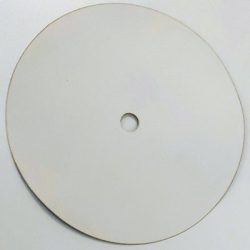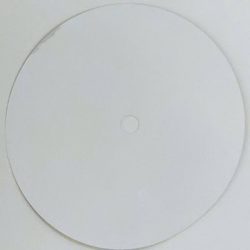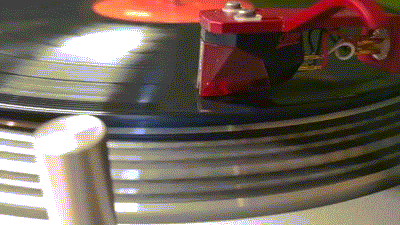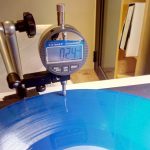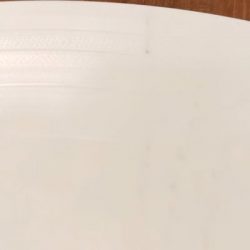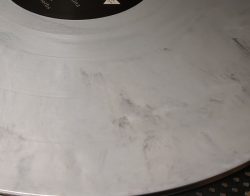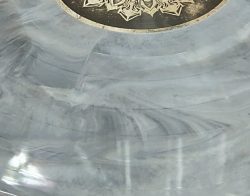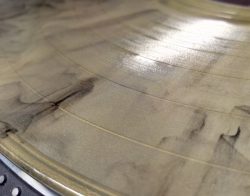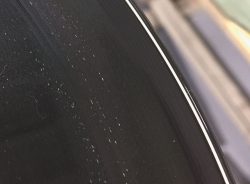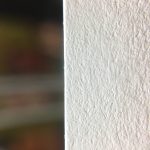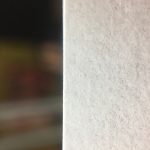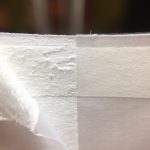Newcomers to vinyl or experienced customers interested to know more about common pitfalls should read this page carefully. We will discuss some common faults or quirks that can happen with easy to understand pictures.
1. Center labels (sometimes also called “stickers”)
Center labels for vinyl are not adhesive or stuck on after pressing – they are made of special paper that is pressed directly into the vinyl. If the labels are not baked completely dry then faults can happen such as bubbles, tears or even the entire label exploding. The baking process will change the color of both the paper and inks, and it is difficult to control exactly how much change will happen even in the same production run. This will be most obvious on a label with white base and some dark text or graphics. Sometimes A/B labels may have different shades due to different baking periods. An example is shown of normal yellowing that occurs after baking.
2. Warping / dishing
Edge measurement
Of course we all prefer it when vinyl is perfectly flat, but did you know prioritizing a totally flat record can sometimes affect the sound? Pressing vinyl is a complicated process that takes time to learn. Engineers need to figure out the right amount of heat and pressure to press for the right amount of time to make the perfect record. Each record has different patterns of grooves so each project is different and unique. Sometimes a record needs an extra long cycle or very hot moulds for optimum sound, and in this case a small amount of warping can happen as the records cool. We minimize warping by using an individual cooling plate between each record (we are one of very few plants in the world to do this, as it’s very time consuming). But still it might not always be possible to get records totally flat without increasing noise. We measure the flatness of finished records using a micrometer gauge and laser level on a specially modified turntable. A pressing is rejected if the delta (difference between highest and lowest) is more than 0.50mm in a single revolution at the outside edge, or there is more than 3mm difference between the outer edge and center of a 12″ record.
3. Color mixing on color records
Vinyl records are pressed after first heating PVC pellets in an extruder that turns solid PVC into a semi-liquid snake. Even when a deep cleaning is performed if lighter colors are chosen it’s possible to have old compound such as black release from inside the extruder screw and show up as darker spots against the lighter PVC. Even a very tiny amount of black compound will show up on white or glass transparent vinyl.
It’s possible to order pure white or pure glass transparent for an extra fee (contact your account rep) but we strongly recommend against this as it’s pretty bad for the environment and means otherwise almost perfect records get thrown away.
4. Marble color variations
Marble vinyl is made by mixing different color PVC pellets in a hopper before they are melted and extruded. This makes a random swirl effect. No two records are alike and while it is possible to somewhat control the intensity of marble there can be a big variation between different production runs or different records in the same run. Marble works best with a light base color and dark marble. If you have a specific effect in mind you can specify a light or heavy marble, but results are not guaranteed.
- White Base + Black Marble (light marble)
- White Base + Black Marble (heavy marble)
- Gold Base + Black Marble (standard marble)
Marble vinyl generally has worse sound quality than solid colors or black as each PVC color has a slightly different melt temperature and sometimes clicks, rumbles etc. will be heard through color transitions. Best sound quality is achieved when similar colors are used – for example light green and dark green.
Color pellets will mix together like paint, so for example yellow and blue marble will result in greenish colored vinyl with yellow and blue streaks.
5. Physical pressing defects – stitching/nonfill
Along with measurements and inspection of audio Mobineko staff also visually inspect every record for signs of pressing defects. Certain defects such as stitching can be seen visually on a record. Stitching is caused by PVC material remaining partially in the grooves of a stamper mould, it’s often confused with non-fill but that is usually only visible under a microscope.
We always perform further inspection on records that show signs of stitching. Usually these records will be discarded and settings adjusted, but in some cases the sound is not affected. In rare cases a new stamper may be required as the cutting or plating process can leave hooks or horns inside a grove that grab onto molten PVC and damage the record grooves when separating a freshly made record from the moulds.
6. Innersleeves / protecting your records
Innersleeves are often overlooked when talking about quality but they are super important for protecting your precious records. Mobineko’s standard free innersleeves feature extra heavy 150gsm paper and a plasticized coating on the inside to help prevent scratches. However this protection is still not as good as an anti static PE plastic inner or polylined inner. You may also see a light coating of oil expressed from both the PVC material itself and the plastic coating – this will not damage your turntable cartridge but can be gently wiped off with a good quality anti static cloth such as 3M optical wipes. The good news is that scratches caused from records rubbing against their inners does not affect the sound at all since music is cut deep inside the grooves. If minimal scratches and aesthetic of your records is important, choose PE or polylined inners.
7. Surface noise – clicks/pops/rumble
QC lab
It can be hard to define normal sounds that are part of vinyl (the light clicks, pops and so on) and unacceptable noise due to poor quality plating, bad lacquers or pressing errors. Some noise does have to be accepted as part of the vinyl experience, but we think it’s more than compensated by the rich natural compression that can only be created by a cutter head and gives that “fat” vinyl sound.
Mobineko has spent several years refining our quality control process using a combination of experienced staff, custom software and hardware tools. We have reviewed several hundred records pressed by various plants across several decades and carefully studied RIAA documents for vinyl pressing standards. We used this research to come up with a baseline for “quiet” or “noisy” pressings.
Along with listening to records just to make sure they sound great we think it’s important to take accurate and consistent measurements wherever possible. We take a sampling of records from each run and measure various key sections to determine the levels of surface noise, click frequency and more. We also measure frequency response plotted against the source audio. All of this data is stored in a database so we can quickly see trends in raw material quality, operator proficiency or even effects of weather. Quality control is done in a dedicated quiet room that is electrically and acoustically isolated.
